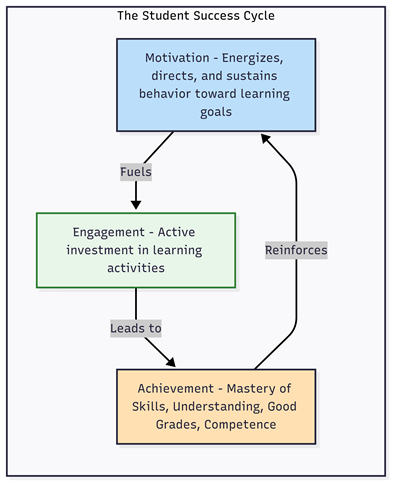The Student Success Cycle
Motivation, engagement, and achievement are not isolated concepts but rather a deeply interconnected system that profoundly influences student success. Understanding their relationship with each other is crucial for educators seeking to foster a thriving learning environment.
This diagram shows how motivation, engagement, and achievement are not linear endpoints but rather a self-reinforcing loop where each element energizes the next.

- Motivation (The "Why"): This is the launchpad for learning. A student's internal drive sparked by personal interest, clear goals, a belief in their own ability (self-efficacy), and the relevance of the topic provides the initial thrust.
- Engagement (The "How"): Motivation fuels active engagement. A motivated student is more likely to invest the necessary effort, participate in class, think critically about the material, and collaborate with peers. This is where the hard work of learning happens.
- Achievement (The "What"): Consistent and deep engagement leads to tangible results. Students achieve a real understanding of the material, master new skills, and earn good grades. This success is a direct outcome of their active involvement.
The most important part of the cycle is the arrow flowing back from Achievement to Motivation. When students see their hard work pay off, it builds their confidence and self-efficacy. This success reinforces their belief that they can succeed, boosting their motivation to tackle new challenges. This turns the process into a powerful, positive feedback loop, creating upward momentum for sustained learning and success.
Bandura, A. (1997). Self-efficacy: The exercise of control. W. H. Freeman.
Ryan, R. M., & Deci, E. L. (2000). Self-determination theory and the facilitation of intrinsic motivation, social development, and well-being. American Psychologist, 55(1), 68–78. https://doi.org/10.1037/0003-066X.55.1.68
Wigfield, A., & Eccles, J. S. (2000). Expectancy-value theory of achievement motivation. Contemporary Educational Psychology, 25(1), 68-81. https://doi.org/10.1006/ceps.1999.1015
